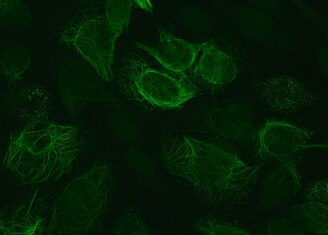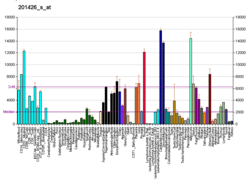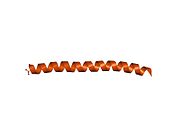
Vimentin is a structural protein that in humans is encoded by the VIM gene. Its name comes from the Latin vimentum which refers to an array of flexible rods.

Vimentin is a type III intermediate filament (IF) protein that is expressed in mesenchymal cells. IF proteins are found in all animal cells as well as bacteria. Intermediate filaments, along with tubulin-based microtubules and actin-based microfilaments, comprises the cytoskeleton. All IF proteins are expressed in a highly developmentally-regulated fashion; vimentin is the major cytoskeletal component of mesenchymal cells. Because of this, vimentin is often used as a marker of mesenchymally-derived cells or cells undergoing an epithelial-to-mesenchymal transition (EMT) during both normal development and metastatic progression.
Structure
The assembly of the fibrous vimentin filament that forms the cytoskeleton follows a gradual sequence. The vimentin monomer has a central α-helical domain, capped on each end by non-helical amino (head) and carboxyl (tail) domains. Two monomers are likely co-translationally expressed in a way that facilitates their interaction forming a coiled-coil dimer, which is the basic subunit of vimentin assembly. A pair of coiled-coil dimers connect in an antiparallel fashion to form a tetramer. Eight tetramers join to form what is known as the unit-length filament (ULF), ULFs then stick to each other and elongate followed by compaction to form the fibrous proteins.
The α-helical sequences contain a pattern of hydrophobic amino acids that contribute to forming a "hydrophobic seal" on the surface of the helix. In addition, there is a periodic distribution of acidic and basic amino acids that seems to play an important role in stabilizing coiled-coil dimers. The spacing of the charged residues is optimal for ionic salt bridges, which allows for the stabilization of the α-helix structure. While this type of stabilization is intuitive for intrachain interactions, rather than interchain interactions, scientists have proposed that perhaps the switch from intrachain salt bridges formed by acidic and basic residues to the interchain ionic associations contributes to the assembly of the filament.
Function
Vimentin plays a significant role in supporting and anchoring the position of the organelles in the cytosol. Vimentin is attached to the nucleus, endoplasmic reticulum, and mitochondria, either laterally or terminally.
The dynamic nature of vimentin is important when offering flexibility to the cell. Scientists found that vimentin provided cells with a resilience absent from the microtubule or actin filament networks, when under mechanical stress in vivo. Therefore, in general, it is accepted that vimentin is the cytoskeletal component responsible for maintaining cell integrity. (It was found that cells without vimentin are extremely delicate when disturbed with a micropuncture). Transgenic mice that lack vimentin appeared normal and did not show functional differences. It is possible that the microtubule network may have compensated for the absence of the intermediate network. This result supports an intimate interaction between microtubules and vimentin. Moreover, when microtubule depolymerizers were present, vimentin reorganization occurred, once again implying a relationship between the two systems. On the other hand, wounded mice that lack the vimentin gene heal slower than their wild type counterparts.
In essence, vimentin is responsible for maintaining cell shape, integrity of the cytoplasm, and stabilizing cytoskeletal interactions. Vimentin has been shown to eliminate toxic proteins in JUNQ and IPOD inclusion bodies in asymmetric division of mammalian cell lines.
Also, vimentin is found to control the transport of low-density lipoprotein, LDL, -derived cholesterol from a lysosome to the site of esterification. With the blocking of transport of LDL-derived cholesterol inside the cell, cells were found to store a much lower percentage of the lipoprotein than normal cells with vimentin. This dependence seems to be the first process of a biochemical function in any cell that depends on a cellular intermediate filament network. This type of dependence has ramifications on the adrenal cells, which rely on cholesteryl esters derived from LDL.
Vimentin plays a role in aggresome formation, where it forms a cage surrounding a core of aggregated protein.
In addition to its conventional intracellular localisation, vimentin can be found extracellularly. Vimentin can be expressed as a cell surface protein and have suggested roles in immune reactions. It can also be released in phosphorylated forms to the extracellular space by activated macrophages, astrocytes are also known to release vimentin.
Clinical significance
It has been used as a sarcoma tumor marker to identify mesenchyme. Its specificity as a biomarker has been disputed by Jerad Gardner. Vimentin is present in spindle cell squameous cell carcinoma.
Methylation of the vimentin gene has been established as a biomarker of colon cancer and this is being utilized in the development of fecal tests for colon cancer. Statistically significant levels of vimentin gene methylation have also been observed in certain upper gastrointestinal pathologies such as Barrett's esophagus, esophageal adenocarcinoma, and intestinal type gastric cancer. High levels of DNA methylation in the promoter region have also been associated with markedly decreased survival in hormone positive breast cancers. Downregulation of vimentin was identified in cystic variant of papillary thyroid carcinoma using a proteomic approach. See also Anti-citrullinated protein antibody for its use in diagnosis of rheumatoid arthritis.
Vimentin was discovered to be an attachment factor for SARS-CoV-2 by Nader Rahimi and colleagues.
Interactions
Vimentin has been shown to interact with:
The 3' UTR of Vimentin mRNA has been found to bind a 46kDa protein.
References
- ^ GRCh38: Ensembl release 89: ENSG00000026025 – Ensembl, May 2017
- ^ GRCm38: Ensembl release 89: ENSMUSG00000026728 – Ensembl, May 2017
- "Human PubMed Reference:". National Center for Biotechnology Information, U.S. National Library of Medicine.
- "Mouse PubMed Reference:". National Center for Biotechnology Information, U.S. National Library of Medicine.
- Franke WW, Schmid E, Osborn M, Weber K (October 1978). "Different intermediate-sized filaments distinguished by immunofluorescence microscopy". Proceedings of the National Academy of Sciences of the United States of America. 75 (10): 5034–5038. Bibcode:1978PNAS...75.5034F. doi:10.1073/pnas.75.10.5034. PMC 336257. PMID 368806.
- Eriksson JE, Dechat T, Grin B, Helfand B, Mendez M, Pallari HM, et al. (July 2009). "Introducing intermediate filaments: from discovery to disease". The Journal of Clinical Investigation. 119 (7): 1763–1771. doi:10.1172/JCI38339. PMC 2701876. PMID 19587451.
- Cabeen MT, Jacobs-Wagner C (2010). "The bacterial cytoskeleton". Annual Review of Genetics. 44: 365–392. doi:10.1146/annurev-genet-102108-134845. PMID 21047262.
- ^ Fuchs E, Weber K (1994). "Intermediate filaments: structure, dynamics, function, and disease". Annual Review of Biochemistry. 63: 345–382. doi:10.1146/annurev.bi.63.070194.002021. PMID 7979242.
- Chang L, Shav-Tal Y, Trcek T, Singer RH, Goldman RD (February 2006). "Assembling an intermediate filament network by dynamic cotranslation". The Journal of Cell Biology. 172 (5): 747–758. doi:10.1083/jcb.200511033. PMC 2063706. PMID 16505169.
- Danielsson F, Peterson MK, Caldeira Araújo H, Lautenschläger F, Gad AK (September 2018). "Vimentin Diversity in Health and Disease". Cells. 7 (10): 147. doi:10.3390/cells7100147. PMC 6210396. PMID 30248895.
- Katsumoto T, Mitsushima A, Kurimura T (1990). "The role of the vimentin intermediate filaments in rat 3Y1 cells elucidated by immunoelectron microscopy and computer-graphic reconstruction". Biology of the Cell. 68 (2): 139–146. doi:10.1016/0248-4900(90)90299-I. PMID 2192768. S2CID 29019928.
- ^ Goldman RD, Khuon S, Chou YH, Opal P, Steinert PM (August 1996). "The function of intermediate filaments in cell shape and cytoskeletal integrity". The Journal of Cell Biology. 134 (4): 971–983. doi:10.1083/jcb.134.4.971. PMC 2120965. PMID 8769421.
- Colucci-Guyon E, Portier MM, Dunia I, Paulin D, Pournin S, Babinet C (November 1994). "Mice lacking vimentin develop and reproduce without an obvious phenotype". Cell. 79 (4): 679–694. doi:10.1016/0092-8674(94)90553-3. PMID 7954832. S2CID 28146121.
- Eckes B, Colucci-Guyon E, Smola H, Nodder S, Babinet C, Krieg T, et al. (July 2000). "Impaired wound healing in embryonic and adult mice lacking vimentin". Journal of Cell Science. 113 (13): 2455–2462. doi:10.1242/jcs.113.13.2455. PMID 10852824.
- Ogrodnik M, Salmonowicz H, Brown R, Turkowska J, Średniawa W, Pattabiraman S, et al. (June 2014). "Dynamic JUNQ inclusion bodies are asymmetrically inherited in mammalian cell lines through the asymmetric partitioning of vimentin". Proceedings of the National Academy of Sciences of the United States of America. 111 (22): 8049–8054. Bibcode:2014PNAS..111.8049O. doi:10.1073/pnas.1324035111. PMC 4050583. PMID 24843142.
- ^ Sarria AJ, Panini SR, Evans RM (September 1992). "A functional role for vimentin intermediate filaments in the metabolism of lipoprotein-derived cholesterol in human SW-13 cells". The Journal of Biological Chemistry. 267 (27): 19455–19463. doi:10.1016/S0021-9258(18)41797-8. PMID 1527066.
- Johnston JA, Ward CL, Kopito RR (December 1998). "Aggresomes: a cellular response to misfolded proteins". The Journal of Cell Biology. 143 (7): 1883–1898. doi:10.1083/jcb.143.7.1883. PMC 2175217. PMID 9864362.
- Paulin D, Lilienbaum A, Kardjian S, Agbulut O, Li Z (June 2022). "Vimentin: Regulation and pathogenesis". Biochimie. 197: 96–112. doi:10.1016/j.biochi.2022.02.003. PMID 35151830. S2CID 246778685.
- Leader M, Collins M, Patel J, Henry K (January 1987). "Vimentin: an evaluation of its role as a tumour marker". Histopathology. 11 (1): 63–72. doi:10.1111/j.1365-2559.1987.tb02609.x. PMID 2435649. S2CID 34804720.
- "Immunohistochemistry from the Washington Animal Disease Diagnostic laboratory (WADDL)of the College of Veterinary Medicine, Washington State University". Archived from the original on 2008-12-01. Retrieved 2009-03-14.
- Gardner J (23 September 2010). "How to Interpret Vimentin Immunostain". YouTube. Archived from the original on 2021-12-12.
- Dotto JE, Glusac EJ (June 2006). "p63 is a useful marker for cutaneous spindle cell squamous cell carcinoma". Journal of Cutaneous Pathology. 33 (6): 413–417. doi:10.1111/j.0303-6987.2006.00477.x. PMID 16776716. S2CID 38273016.
- Barrette K, Van Kelst S, Wouters J, Marasigan V, Fieuws S, Agostinis P, et al. (November 2014). "Epithelial-mesenchymal transition during invasion of cutaneous squamous cell carcinoma is paralleled by AKT activation". The British Journal of Dermatology. 171 (5): 1014–1021. doi:10.1111/bjd.12967. PMID 24628329. S2CID 42440330.
- Moinova H, Leidner RS, Ravi L, Lutterbaugh J, Barnholtz-Sloan JS, Chen Y, et al. (April 2012). "Aberrant vimentin methylation is characteristic of upper gastrointestinal pathologies". Cancer Epidemiology, Biomarkers & Prevention. 21 (4): 594–600. doi:10.1158/1055-9965.EPI-11-1060. PMC 3454489. PMID 22315367.
- Ulirsch J, Fan C, Knafl G, Wu MJ, Coleman B, Perou CM, et al. (January 2013). "Vimentin DNA methylation predicts survival in breast cancer". Breast Cancer Research and Treatment. 137 (2): 383–396. doi:10.1007/s10549-012-2353-5. PMC 3838916. PMID 23239149.
- Dinets A, Pernemalm M, Kjellin H, Sviatoha V, Sofiadis A, Juhlin CC, et al. (2015). "Differential protein expression profiles of cyst fluid from papillary thyroid carcinoma and benign thyroid lesions". PLOS ONE. 10 (5): e0126472. Bibcode:2015PLoSO..1026472D. doi:10.1371/journal.pone.0126472. PMC 4433121. PMID 25978681.
- Amraei R, Xia C, Olejnik J, White MR, Napoleon MA, Lotfollahzadeh S, et al. (February 2022). "Extracellular vimentin is an attachment factor that facilitates SARS-CoV-2 entry into human endothelial cells". Proceedings of the National Academy of Sciences of the United States of America. 119 (6). Bibcode:2022PNAS..11913874A. doi:10.1073/pnas.2113874119. PMC 8833221. PMID 35078919. e2113874119.
- Meng JJ, Bornslaeger EA, Green KJ, Steinert PM, Ip W (August 1997). "Two-hybrid analysis reveals fundamental differences in direct interactions between desmoplakin and cell type-specific intermediate filaments". The Journal of Biological Chemistry. 272 (34): 21495–21503. doi:10.1074/jbc.272.34.21495. PMID 9261168.
- Lopez-Egido J, Cunningham J, Berg M, Oberg K, Bongcam-Rudloff E, Gobl A (August 2002). "Menin's interaction with glial fibrillary acidic protein and vimentin suggests a role for the intermediate filament network in regulating menin activity". Experimental Cell Research. 278 (2): 175–183. doi:10.1006/excr.2002.5575. PMID 12169273.
- Rual JF, Venkatesan K, Hao T, Hirozane-Kishikawa T, Dricot A, Li N, et al. (October 2005). "Towards a proteome-scale map of the human protein-protein interaction network". Nature. 437 (7062): 1173–1178. Bibcode:2005Natur.437.1173R. doi:10.1038/nature04209. PMID 16189514. S2CID 4427026.
- Stelzl U, Worm U, Lalowski M, Haenig C, Brembeck FH, Goehler H, et al. (September 2005). "A human protein-protein interaction network: a resource for annotating the proteome". Cell. 122 (6): 957–968. doi:10.1016/j.cell.2005.08.029. hdl:11858/00-001M-0000-0010-8592-0. PMID 16169070. S2CID 8235923.
- Matsuzawa K, Kosako H, Inagaki N, Shibata H, Mukai H, Ono Y, et al. (May 1997). "Domain-specific phosphorylation of vimentin and glial fibrillary acidic protein by PKN". Biochemical and Biophysical Research Communications. 234 (3): 621–625. doi:10.1006/bbrc.1997.6669. PMID 9175763.
- Ratnayake WS, Apostolatos AH, Ostrov DA, Acevedo-Duncan M (November 2017). "Two novel atypical PKC inhibitors; ACPD and DNDA effectively mitigate cell proliferation and epithelial to mesenchymal transition of metastatic melanoma while inducing apoptosis". International Journal of Oncology. 51 (5): 1370–1382. doi:10.3892/ijo.2017.4131. PMC 5642393. PMID 29048609.
- Ratnayake WS, Apostolatos CA, Apostolatos AH, Schutte RJ, Huynh MA, Ostrov DA, et al. (2018). "Oncogenic PKC-ι activates Vimentin during epithelial-mesenchymal transition in melanoma; a study based on PKC-ι and PKC-ζ specific inhibitors". Cell Adhesion & Migration. 12 (5): 447–463. doi:10.1080/19336918.2018.1471323. PMC 6363030. PMID 29781749.
- Herrmann H, Wiche G (January 1987). "Plectin and IFAP-300K are homologous proteins binding to microtubule-associated proteins 1 and 2 and to the 240-kilodalton subunit of spectrin". The Journal of Biological Chemistry. 262 (3): 1320–1325. doi:10.1016/S0021-9258(19)75789-5. PMID 3027087.
- ^ Brown MJ, Hallam JA, Liu Y, Yamada KM, Shaw S (July 2001). "Cutting edge: integration of human T lymphocyte cytoskeleton by the cytolinker plectin". Journal of Immunology. 167 (2): 641–645. doi:10.4049/jimmunol.167.2.641. PMID 11441066.
- Russell RL, Cao D, Zhang D, Handschumacher RE, Pizzorno G (April 2001). "Uridine phosphorylase association with vimentin. Intracellular distribution and localization". The Journal of Biological Chemistry. 276 (16): 13302–13307. doi:10.1074/jbc.M008512200. PMID 11278417.
- Tzivion G, Luo ZJ, Avruch J (September 2000). "Calyculin A-induced vimentin phosphorylation sequesters 14-3-3 and displaces other 14-3-3 partners in vivo". The Journal of Biological Chemistry. 275 (38): 29772–29778. doi:10.1074/jbc.M001207200. PMID 10887173.
- Zehner ZE, Shepherd RK, Gabryszuk J, Fu TF, Al-Ali M, Holmes WM (August 1997). "RNA-protein interactions within the 3 ' untranslated region of vimentin mRNA". Nucleic Acids Research. 25 (16): 3362–3370. doi:10.1093/nar/25.16.3362. PMC 146884. PMID 9241253.
Further reading
- Snásel J, Pichová I (1997). "The cleavage of host cell proteins by HIV-1 protease". Folia Biologica. 42 (5): 227–230. doi:10.1007/BF02818986. PMID 8997639. S2CID 7617882.
- Lake JA, Carr J, Feng F, Mundy L, Burrell C, Li P (February 2003). "The role of Vif during HIV-1 infection: interaction with novel host cellular factors". Journal of Clinical Virology. 26 (2): 143–152. doi:10.1016/S1386-6532(02)00113-0. PMID 12600646.
External links
| PDB gallery | |
|---|---|
| Proteins of the cytoskeleton | |||||||||||||||||||||||||||||||||||||||||||||||||||||
|---|---|---|---|---|---|---|---|---|---|---|---|---|---|---|---|---|---|---|---|---|---|---|---|---|---|---|---|---|---|---|---|---|---|---|---|---|---|---|---|---|---|---|---|---|---|---|---|---|---|---|---|---|---|
| Human |
| ||||||||||||||||||||||||||||||||||||||||||||||||||||
| Nonhuman | |||||||||||||||||||||||||||||||||||||||||||||||||||||
| See also: cytoskeletal defects | |||||||||||||||||||||||||||||||||||||||||||||||||||||
| Tumor markers | |||||||||||||
|---|---|---|---|---|---|---|---|---|---|---|---|---|---|
| Blood |
| ||||||||||||
| Endocrine |
| ||||||||||||
| Nervous system |
| ||||||||||||
| Cardiovascular/ respiratory |
| ||||||||||||
| Digestive |
| ||||||||||||
| Reproductive/ urinary/ breast |
| ||||||||||||
| General histology |
| ||||||||||||
| Musculoskeletal |
| ||||||||||||







